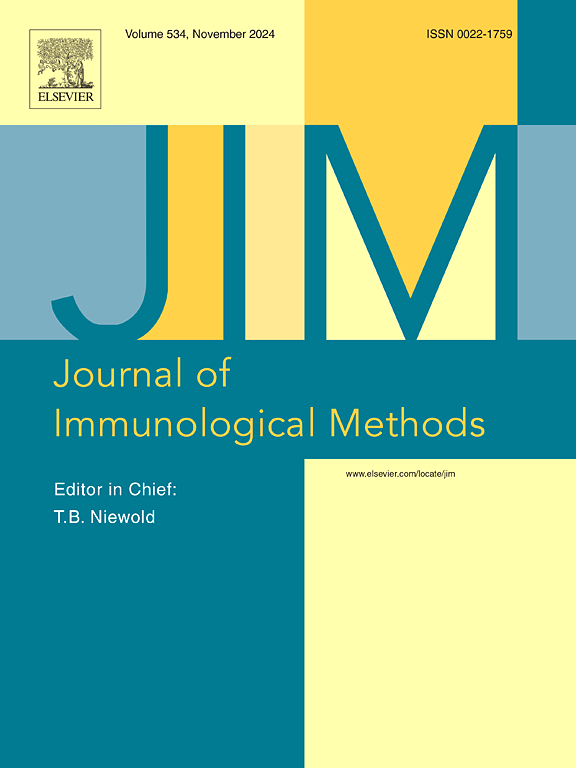猪瘟病毒抗原检测的肽驱动侧流平台。
IF 1.6
4区 医学
Q4 BIOCHEMICAL RESEARCH METHODS
引用次数: 0
摘要
经典猪瘟(CSF)是一种高度传染性的病毒性疾病,给养猪业造成巨大的经济损失。及时发现CSFV感染对有效控制疾病至关重要;然而,目前基于抗体的诊断方法由于宿主免疫反应的延迟而受到限制。在这项研究中,我们开发了一种新的基于肽的横向流动试验(LFA),靶向经典猪瘟病毒(CSFV)的E2抗原,以实现快速和现场部署的检测。通过生物信息学分析,从CSFV E2蛋白的免疫优势区合成了一个合成肽,并将其偶联到Keyhole Limpet Hemocyanin (KLH)上,以增强其免疫原性。在家兔中产生多克隆抗体,经纯化,并通过ELISA验证其对猪瘟病毒的特异性,显示与其他猪病毒如ASFV、PRRSV、PCV2和PPV无交叉反应。以芒果叶提取物为原料合成银纳米粒子(AgNPs),并采用紫外可见光谱(UV-vis)、红外光谱(FTIR)和动态光散射(DLS)对其进行了表征。然后将这些纳米颗粒与纯化的抗e2抗体结合并纳入LFA条带。结果表明,该方法灵敏度高,能够检测到低至20 ng/ml的猪瘟抗原,具有良好的特异性和无交叉反应性。这种基于肽的LFA为现场CSF监测和疫情管理提供了一种快速、可靠和具有成本效益的诊断工具。本文章由计算机程序翻译,如有差异,请以英文原文为准。
Peptide-driven lateral flow platform for detection of classical swine fever viral antigen
Classical Swine Fever (CSF) is a highly contagious viral disease that causes substantial economic losses in the swine industry. Timely detection of CSFV infection is essential for effective disease control; however, current antibody-based diagnostic methods are limited due to the delayed host immune response. In this study, we developed a novel peptide-based lateral flow assay (LFA) targeting the E2 antigen of the Classical Swine Fever Virus (CSFV) to enable rapid and field-deployable detection. A synthetic peptide derived from the immunodominant region of the CSFV E2 protein was identified through bioinformatics analysis, synthesized, and conjugated to Keyhole Limpet Hemocyanin (KLH) to enhance its immunogenicity. Polyclonal antibodies were generated in rabbits, purified, and validated via ELISA to confirm specificity to CSFV, showing no cross-reactivity with other swine viruses such as ASFV, PRRSV, PCV2, and PPV. Silver nanoparticles (AgNPs) were biosynthesized using Mangifera indica leaf extract and characterized by UV–vis spectroscopy, FTIR, and dynamic light scattering (DLS). These nanoparticles were then conjugated to the purified anti-E2 antibodies and incorporated into LFA strips. The resulting assay exhibited high sensitivity, capable of detecting CSFV antigen concentrations as low as 20 ng/ml, with excellent specificity and no cross-reactivity. This peptide-based LFA provides a rapid, reliable, and cost-effective diagnostic tool for on-site CSF surveillance and outbreak management.
求助全文
通过发布文献求助,成功后即可免费获取论文全文。
去求助
来源期刊
CiteScore
4.10
自引率
0.00%
发文量
120
审稿时长
3 months
期刊介绍:
The Journal of Immunological Methods is devoted to covering techniques for: (1) Quantitating and detecting antibodies and/or antigens. (2) Purifying immunoglobulins, lymphokines and other molecules of the immune system. (3) Isolating antigens and other substances important in immunological processes. (4) Labelling antigens and antibodies. (5) Localizing antigens and/or antibodies in tissues and cells. (6) Detecting, and fractionating immunocompetent cells. (7) Assaying for cellular immunity. (8) Documenting cell-cell interactions. (9) Initiating immunity and unresponsiveness. (10) Transplanting tissues. (11) Studying items closely related to immunity such as complement, reticuloendothelial system and others. (12) Molecular techniques for studying immune cells and their receptors. (13) Imaging of the immune system. (14) Methods for production or their fragments in eukaryotic and prokaryotic cells.
In addition the journal will publish articles on novel methods for analysing the organization, structure and expression of genes for immunologically important molecules such as immunoglobulins, T cell receptors and accessory molecules involved in antigen recognition, processing and presentation. Submitted full length manuscripts should describe new methods of broad applicability to immunology and not simply the application of an established method to a particular substance - although papers describing such applications may be considered for publication as a short Technical Note. Review articles will also be published by the Journal of Immunological Methods. In general these manuscripts are by solicitation however anyone interested in submitting a review can contact the Reviews Editor and provide an outline of the proposed review.

 求助内容:
求助内容: 应助结果提醒方式:
应助结果提醒方式:


